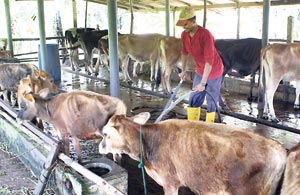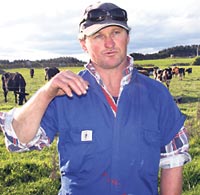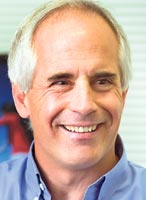Chandana Rupesinghe Gunawardene wakes up at the crack of dawn, dons his working clothes including yellow galoshes and does what he has been doing for the past six years.
He bathes his cows, feeds them and then milks them manually and takes 20 litres of milk on his bicycle to a collecting centre about four miles from his three-acre farm in Polhena, close to Kaluaggala in the Avissawella district.
 |
| Chandana at work at his Polhena farm. |
Chandana, who always wanted to be a dairy farmer, is into growing special grasses to improve milk production while reducing the poonac given to his cows.
Half-a-world away, on a chilly wintry morn 42-year-old Gavin Vanner is also engaged in work similar to that of Chandana.
For Gavin, wife Wendy and three little daughters Eva, Hilary and Bernadine, owners of the 380-hectare Spence View Farms, in Taranaki, New Zealand (NZ), however, the operation is much bigger.
Gavin too always wanted to be a dairy farmer and now he owns 900 Jersey and Friesian cows and milks them twice a day, seven days a week.
It takes only two-and-a half hours to milk the cows, he smiles – because, unlike Chandana, the milking is done through machines in a 60-bale rotary shed which revolves slowly taking in the cows from one entrance, rotating them full circle while milking is on, and gently pushing them out to pasture again.
They resort to artificial insemination to “get the best genetics”, says Gavin, explaining that at the time a group of journalists from Asia and West Asia visited the farm, the “season” had just begun and 400 of the cows had calved and milking was in full swing.
Whereas Chandana provides 20 litres of milk a day to a collection centre in Sri Lanka, Gavin pumps the 16,000 litres of milk collected from his cows daily to a tanker which comes to his farm.
The milk from Chandana’s comparatively small farm is utilized to make yoghurt while the “white gold” as New Zealanders call milk as opposed to the “black gold” of oil, from Gavin’s massive farm may very well be ending up as Anchor powdered milk on our tables.
 |
| Cows at Spence View Farms |
Both Chandana and Gavin are part of a network of farmers feeding milk to the largest dairy and dairy-products producer in the world – Fonterra Co-operative Group Limited headquartered in Auckland with massive plants spread across NZ and abroad. Incidentally, ‘Fon’ means fountain or spring and denotes coming from water while ‘terra’ means earth or land and denotes originating from the soil.
The moment one enters the world of Fonterra, a phrase oft heard is: “Milk is in our veins”, while each and everyone, starting from the topmost level of Chief Executive Officer Andrew Ferrier through to the technical and factory people, the medical and research staff and down to the farmer, talks with passion about “quality”.
And if milk is synonymous with NZ which exports 95% of the milk produced in the country, then Fonterra seems synonymous not only with milk but also milk products. “Fonterra collects 90% of all the milk produced in New Zealand,” said Graeme McMillan, Group Director Communications, adding that it is responsible for 25% of the country’s exports.
Farmers’ company
Fonterra is run on a unique co-operative basis, where the company is owned by 10,500 farmers.
 |
| Gavin: Shareholder farmer |
Of the 18 billion litres of milk collected by Fonterra annually, 14 billion come out of NZ and 1.8 billion from Australia, 1.7 billion from Brazil and 493 million from Chile, the Sunday Times learns.
There is milk collection from other parts of the world, in case there is drought and milk production in NZ is affected, explains Mr. McMillan.
Detailing the specifics of the operation, he says Fonterra’s 400 tankers travel 74 million km a year, transporting milk from farms to 28 sites in NZ, including the world’s largest dairy processing site in Whareroa, Taranaki.
Much of the Taranaki milk, about 27% of Fonterra’s exports, makes its way to consumers in Asia, it is learnt and the famous symbol on all Anchor products in Sri Lanka – where 2,000 glasses of Anchor milk are consumed every minute -- is the snow-capped volcanic Mount Taranaki.
To the question how the NZ milk industry is different to others, he has a simple answer: “It is a pastoral-driven dairy industry where farmers don’t feed their cows such stuff as corn etc,” he says explaining that in other countries the dairy industry has sustainability issues when the price of grain goes up.
The stress is on quality, as General Manager – Technical, Mark Leslie explains. Fonterra has developed the world-best practice processes through its supply chain – from the moment the milk leaves the farm until it reaches the customers. “Our raw milk comes from the best ingredients – clean air, green grass and healthy cows that are pasture-fed, with little added artificial feed or supplements.” The gargantuan challenge is to maintain quality across the supply chain -- 4 million cows, 18 billion litres, 85 origin sites, 90 origin stores, 11 origin ports, 1,500 voyages, 280 destination ports, 100+ destination stores, 5,000 customers and millions of consumers.
From the point of collection, all of Fonterra’s milk goes through a series of rigorous testing procedures to ensure its quality is preserved, he says, stressing that milk that doesn’t meet its high standards is rejected.
“Milk is tested for composition, quality and contaminants at the point of collection on the farm and every batch is then tested again for a range of microbiological, chemical and foreign matter contaminants. This testing includes sampling during the manufacturing process, along with the final product immediately prior to packing,” he says.
Only quality-verified ingredients such as vitamins are added. All batches of finished products are also subjected to final testing, with retention samples being taken, to make sure that if something goes wrong it can be traced back.
“For Fonterra, being able to trace any product back to the farm is another strength of its integrated supply chain,” says Mr. Leslie.
The farms are also checked to make sure they meet a range of animal health, hygiene and quality standards not only set by Fonterra itself but also by the New Zealand Food Safety Authority, it is understood.
Pinpointing the three important factors on which Fonterra operates, Director Communications Mr. McMillan adds that their priority is to take the nutritious value of milk to the world, while maintaining quality and sustainability.
(The writer was on a media tour organised by Fonterra, NZ)
Lanka is an important market
Consumers are the priority, stresses Fonterra Chief Executive Officer Andrew Ferrier, pointing out that they win in business not only by selling products that consumers want but also by continuing to innovate and coming up with new products while improving the old products.
“We give preference to consumers by providing premium and consumer products. We’ve been in Sri Lanka for a long time and are excited about introducing new products to the country particularly yoghurt and cultured dairy products, which are hugely popular in many parts of the world,” he told the Sunday Times in an interview.
 |
| Fonterra Chief Executive Officer Andrew Ferrier |
When asked whether the melamine scandal had an impact, he conceded; “may be briefly but not in any significant way”.
Asked what plans Fonterra had to meet inroads being made into their markets by competitors, Mr. Ferrier stressed that they would sell the brands that consumers in Sri Lanka want and “protect our brands against untrue allegations by defending ourselves vigorously”.
Explaining that he personally follows the business in Sri Lanka carefully, he said Fonterra works with farmer suppliers to increase their technical capability and also in the spheres of animal health and welfare.
Earlier, he began a media briefing by giving an anecdote from Sri Lanka about a New Zealander who was on a visit to this country who had been asked by a trishaw driver where he was from. When told that he was from NZ, he had expected the trishaw driver to mention the Kiwi cricket team but to his surprise, the man had told him that he and his family had always drunk Anchor milk.
Sri Lanka dubbed “one of Fonterra’s most important international markets” has been consuming its flagship Anchor brand for 25 years, the Sunday Times learns. Anchor full cream milk powder is recorded to be the number one seller among milk powder here.
Fonterra Sri Lanka’s manufacturing operations are based at Biyagama. with nine centres in the country collecting 25,000 litres of milk a day from nearly 4,000 farmers. |
|




